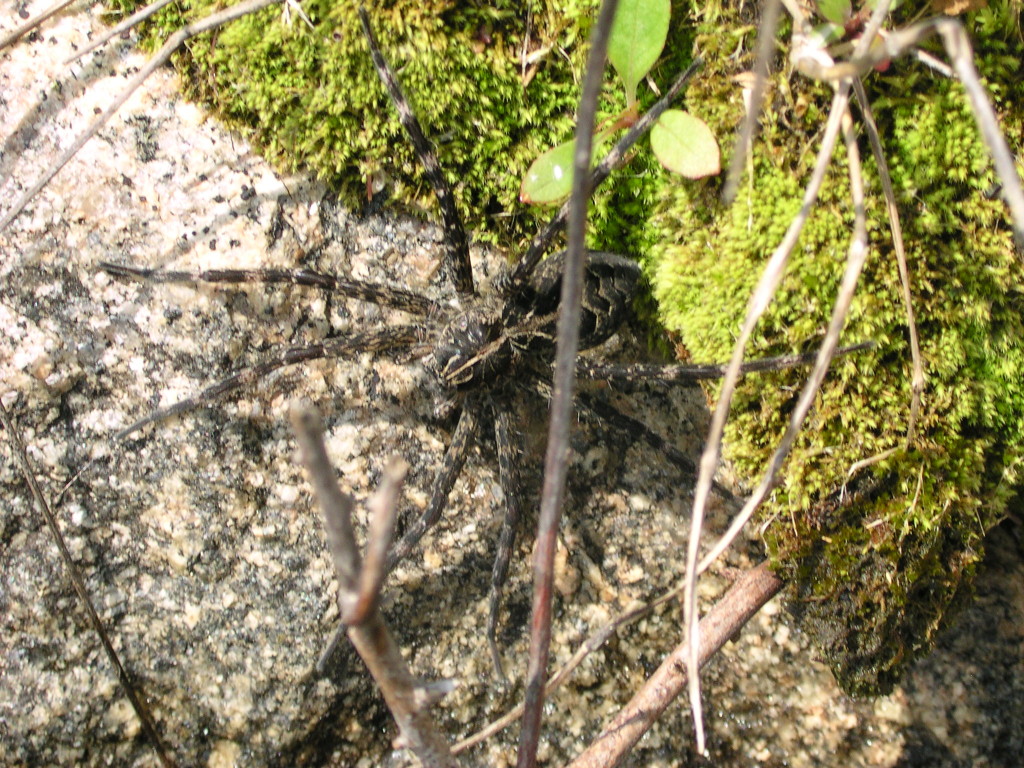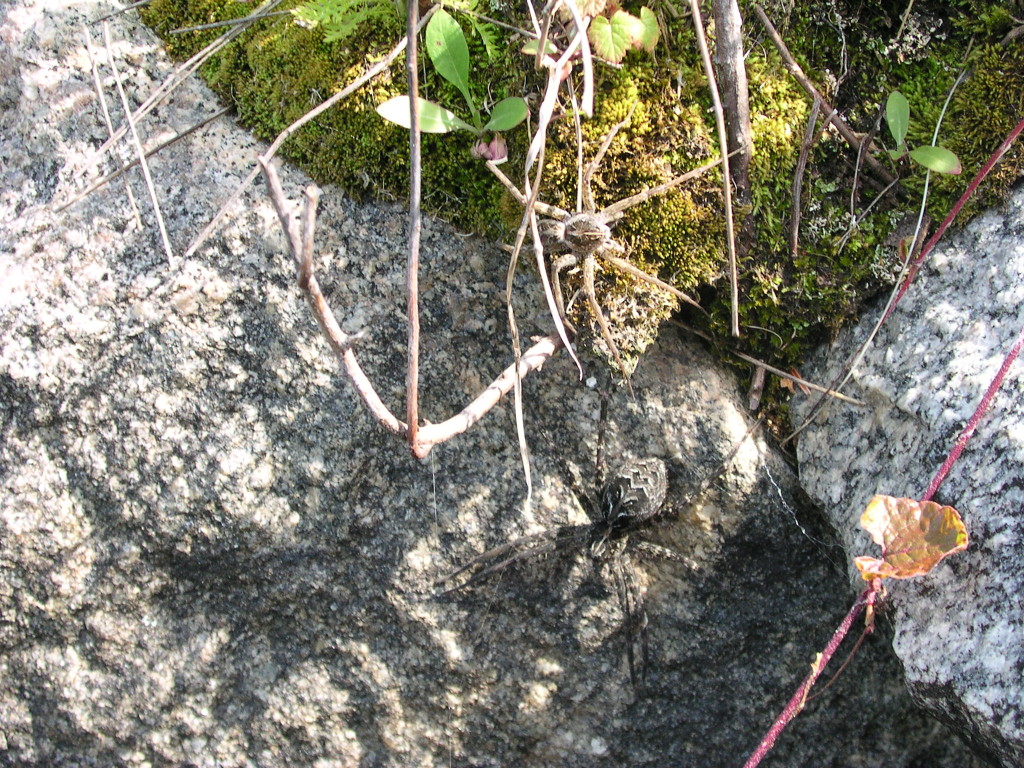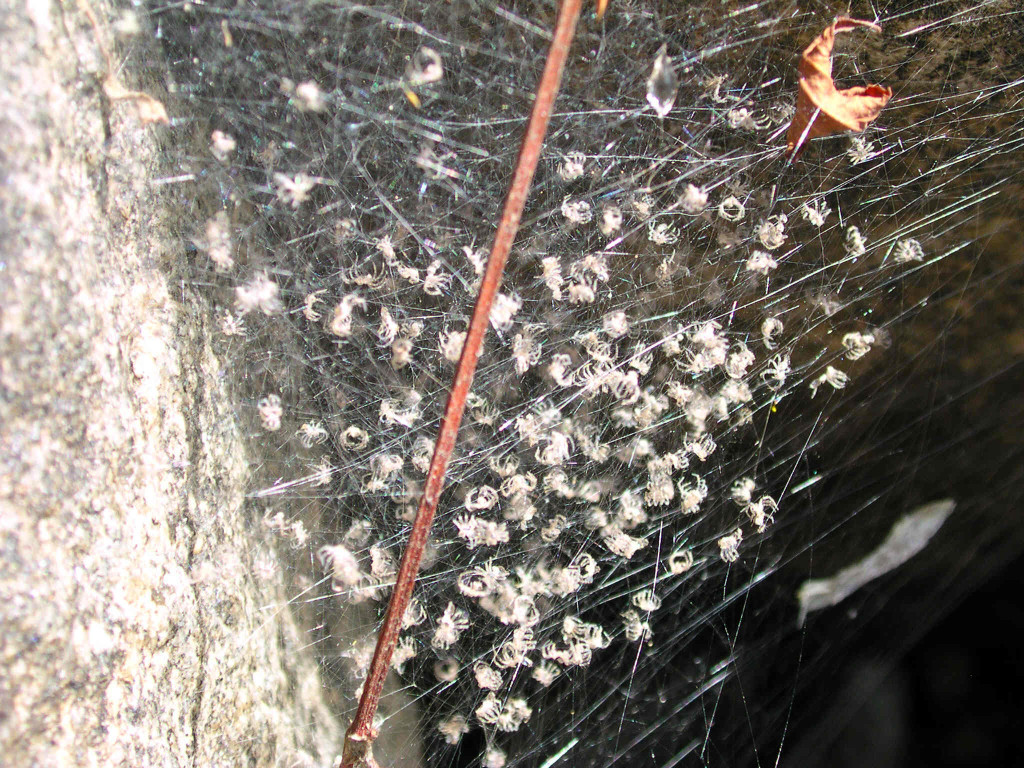Science Seen Physicist and Time One author Colin Gillespie helps you understand your world.
Spider Story
Tweedledum and Tweedledee
Agreed to have a battle!
Lewis Carroll (1871)
 ‘Our rock,’ we call it. Its tons of granite became solid some two billion years ago. Most recently―maybe ten thousand years ago―a glacier left it on the shoreline of a lake.
‘Our rock,’ we call it. Its tons of granite became solid some two billion years ago. Most recently―maybe ten thousand years ago―a glacier left it on the shoreline of a lake.
On July 6 the spider shows up on our rock. She keeps to herself on one corner. She is (we will soon see she is a she) a fishing spider with a more-than-three-inch span. Her camouflage is suited to her situation. From time to time we locate her so we can leave her well alone.
She walks on water. Unwitting, she is using physics. Quantum calculations show how molecules of water cling to one another. So rather than embrace her hairy legs the water surface bends and, trampoline-like, holds her up. This same physics clads her hide in silver sheens of air to breathe when she climbs underneath the surface, as she will to kill a fish. Not for nothing is she called a fishing spider.
 Aspiring-suitor spider shows up July 20 making dry sounds as he threads his way through twigs and leaves. His colors match, not rock, but vegetation. (Do you see two spiders here?) Nearing her, his advance becomes almost imperceptible. He taps his front legs to announce his presence. Tweedledum, we call him, to her Tweedledee. When Dum comes close, Dee lunges and Dum cringes back to square one. Nightfall cloaks the climax of their courtship tango.
Aspiring-suitor spider shows up July 20 making dry sounds as he threads his way through twigs and leaves. His colors match, not rock, but vegetation. (Do you see two spiders here?) Nearing her, his advance becomes almost imperceptible. He taps his front legs to announce his presence. Tweedledum, we call him, to her Tweedledee. When Dum comes close, Dee lunges and Dum cringes back to square one. Nightfall cloaks the climax of their courtship tango.
One week later she is carrying a sack of eggs. Its bulk is more than half her size and yet her girth seems undiminished. There’s no sign of him.
She spins a web across a cleft six inches from her month-long habitation. It is dense and three-dimensioned. She stands guard and soon it swarms with spiderlings. Cloudlike they react with panic to our every move. She keeps her cool. Can she be so sure of our intentions?
 August 25, no sign of life. The web holds only husks. Counting, we lose track but there are hundreds. Did so many die? we wonder.
August 25, no sign of life. The web holds only husks. Counting, we lose track but there are hundreds. Did so many die? we wonder.
Checking spider habits, we surmise they needed room to grow and shed their skins, then scattered. Scads of soft-skinned spiderlings went skittering across our rock and into woods and crevices. We know their chances. Odds are only one will live to sire and one to bear, almost two years from now, their next-gen crop of fishing spiders.
Sources
Lewis Carroll (1871), Through the Looking Glass, London: Macmillan; http://sabian.org/looking_glass4.php
Related Reading:
“Q&A: What is surface tension?”, Ask the Van, Urbana-Champaign: University of Illinois, post, 1 August 2006, https://van.physics.illinois.edu/qa/listing.php?id=2217
Beth Swarecki (2014), “Slideshow: Fish-eating spiders more common than thought”, Science, Washington: AAAS, News post, 18 June, http://news.sciencemag.org/plants-animals/2014/06/slideshow-fish-eating-spiders-more-common-thought?rss=1
Howard Russell (2010), “Fishing Spiders”, Michigan State University, News post, 11 June, http://msue.anr.msu.edu/news/fishing_spiders
Tom Harris (2002), “How Spiders Work”, HowStuffWorks, 8 August, http://animals.howstuffworks.com/arachnids/spider2.htm
Image credits: Colin Gillespie

Loved reading about fishing spiders, surface tension, spider courtship, raising baby spiders and camouflage all in one short blog. It is Sunday morning and I am passing the time looking at my computer and Voila! I suddenly am reading some lovely words full of interest and beauty and information. The best part was that I have skate bugs in my pool and I can go in the kitchen now and tell my husband exactly how it is that they can skate. Thank you so much for the serendipitous moment .